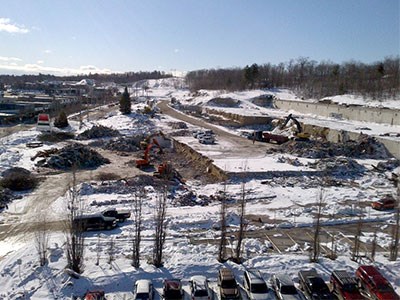As March approached, everyone in Elliot Lake was eager to see the construction of the new shopping mall get started, but Mother Nature had other ideas in mind.
J.I. Enterprises had to halt site preparation after winter—longer and harsher than anticipated—decided to stick around and throw a wrench into plans. Blasting had to be put on hold, and the site developers decided to work on a retaining wall instead. But even that proved difficult.
“What they were finding was it would take them 10 minutes to put a block on the retaining wall, but it would take them 45 minutes to clean all the snow and ice off it,” said William Elliott, general manager of the Elliot Lake and North Shore Corporation for Business Development (ELNOS), which is facilitating the project.
“It was crazy. So we finally said, ‘Let’s just wait a couple of weeks until the weather turns, and we can get back at it.’ And, of course, the weather hasn’t turned.”
That delay has pushed back the project by about six weeks, and added slightly to the original $3-million price tag, since there are costs associated with the demobilization and mobilization of the equipment, Elliott said. But that should be offset by the sale price, which was increased after developers added a chunk of land to the mall’s original footprint.
“It will up the price because there’s more to be developed,” Elliott said. “But part of the balance is that there’s more site to be sold then, too.”
The developer, McCowan & Associates out of Barrie, has been understanding about the delay, as has at least one tenant, a food store that wanted to open its doors to the public by December, Elliott said. A few options were being considered to up the pace of site prep, including getting an extension from the city on working hours to expand the construction day.
Elliott anticipated workers would be back on site by April 8.
Site plans got final approval on April 3, and the mall looks only slightly different from its original concept. It encompasses 103,358 square feet, of which 98,000 square feet comprise store space. The original footprint was increased after one of the tenants asked for more space.
All the other elements requested by the city—a single-level design, enclosed transit between stores, and a food court/social gathering space—have been incorporated, Elliott said.
“It’s almost identical to what they first proposed,” Elliott said. “People are going to be very happy with this.”
The next step is to finalize the leases with store owners, and then Elliott expects tenants will start announcing their tenure in the mall.
As the new mall rises, the old mall is quickly being demolished. Only a few supporting cement walls and debris piles remain on the site. The scene has changed drastically from the one last June, when two women were killed and 20 people were injured following the collapse of a portion of the mall’s roof.
Residents have watched the demolition with interest.
“When it started coming down, it was a big relief for a lot of people,” Elliott said. “It’s kind of a cathartic thing to get people to move on.”
A year-long public inquiry is simultaneously underway. Convened March 4 and headed by Paul R. Bélanger, the inquiry is designed to examine the events leading up to the roof collapse; the deaths of Lucie Aylwin and Doloris Perizzolo, along with the injuries to others; and the emergency management and response.
A report released by engineering firm NORR on March 19 indicated the roof collapse was caused by the corrosion of a steel beam due to water leakage.
Noting that leaks were present shortly after the mall opened, the report indicates the collapse was triggered as a result of a loss of a section of weld connecting a roof beam and a column. Corrosion—and not an excess in the design load—weakened the connection, and the beam could no longer support the weight of the roof, the report says.
The failure occurred in two parts: corrosion that took place over several months weakened the structure and continued to corrode, eventually shearing off during the roof collapse.
“The significance of the two-stage failure is that the depletion of capacity went on for a long time and collapse was in the making for years,” the report states. “It is, in fact, somewhat surprising that failure did not happen earlier.”
The Elliot Lake Inquiry is ongoing.
Click here for more articles on the Elliot Lake Mall Collapse.




